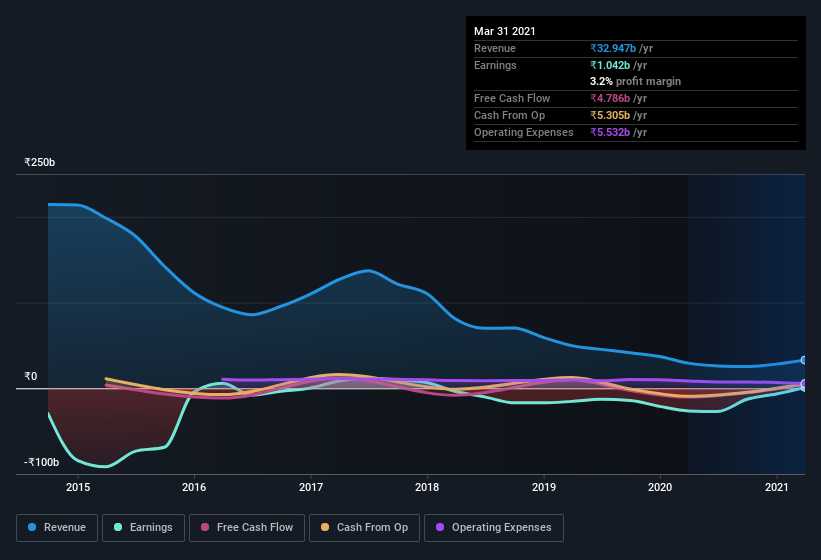- India
- /
- Electrical
- /
- NSEI:SUZLON
Suzlon Energy (NSE:SUZLON) Posted Healthy Earnings But There Are Some Other Factors To Be Aware Of

Suzlon Energy Limited (NSE:SUZLON) just reported some strong earnings, and the market rewarded them with a positive share price move. We did some analysis and think that investors are missing some details hidden beneath the profit numbers.
View our latest analysis for Suzlon Energy

Examining Cashflow Against Suzlon Energy's Earnings
Many investors haven't heard of the accrual ratio from cashflow, but it is actually a useful measure of how well a company's profit is backed up by free cash flow (FCF) during a given period. The accrual ratio subtracts the FCF from the profit for a given period, and divides the result by the average operating assets of the company over that time. You could think of the accrual ratio from cashflow as the 'non-FCF profit ratio'.
Therefore, it's actually considered a good thing when a company has a negative accrual ratio, but a bad thing if its accrual ratio is positive. While having an accrual ratio above zero is of little concern, we do think it's worth noting when a company has a relatively high accrual ratio. That's because some academic studies have suggested that high accruals ratios tend to lead to lower profit or less profit growth.
Suzlon Energy has an accrual ratio of -0.17 for the year to March 2021. That indicates that its free cash flow quite significantly exceeded its statutory profit. Indeed, in the last twelve months it reported free cash flow of ₹4.8b, well over the ₹1.04b it reported in profit. Given that Suzlon Energy had negative free cash flow in the prior corresponding period, the trailing twelve month resul of ₹4.8b would seem to be a step in the right direction. However, that's not the end of the story. We must also consider the impact of unusual items on statutory profit (and thus the accrual ratio), as well as note the ramifications of the company issuing new shares.
Note: we always recommend investors check balance sheet strength. Click here to be taken to our balance sheet analysis of Suzlon Energy.
One essential aspect of assessing earnings quality is to look at how much a company is diluting shareholders. Suzlon Energy expanded the number of shares on issue by 15% over the last year. As a result, its net income is now split between a greater number of shares. Per share metrics like EPS help us understand how much actual shareholders are benefitting from the company's profits, while the net income level gives us a better view of the company's absolute size. You can see a chart of Suzlon Energy's EPS by clicking here.
A Look At The Impact Of Suzlon Energy's Dilution on Its Earnings Per Share (EPS).
Three years ago, Suzlon Energy lost money. And even focusing only on the last twelve months, we don't have a meaningful growth rate because it made a loss a year ago, too. But mathematics aside, it is always good to see when a formerly unprofitable business come good (though we accept profit would have been higher if dilution had not been required). And so, you can see quite clearly that dilution is influencing shareholder earnings.
In the long term, if Suzlon Energy's earnings per share can increase, then the share price should too. But on the other hand, we'd be far less excited to learn profit (but not EPS) was improving. For the ordinary retail shareholder, EPS is a great measure to check your hypothetical "share" of the company's profit.
How Do Unusual Items Influence Profit?
Surprisingly, given Suzlon Energy's accrual ratio implied strong cash conversion, its paper profit was actually boosted by ₹8.1b in unusual items. While we like to see profit increases, we tend to be a little more cautious when unusual items have made a big contribution. We ran the numbers on most publicly listed companies worldwide, and it's very common for unusual items to be once-off in nature. Which is hardly surprising, given the name. We can see that Suzlon Energy's positive unusual items were quite significant relative to its profit in the year to March 2021. As a result, we can surmise that the unusual items are making its statutory profit significantly stronger than it would otherwise be.
Our Take On Suzlon Energy's Profit Performance
In conclusion, Suzlon Energy's accrual ratio suggests its earnings are well backed by cash but its boost from unusual items is probably not going to be repeated consistently. Meanwhile, the dilution was a negative for shareholders. After taking into account all the aforementioned observations we think that Suzlon Energy's profits probably give a generous impression of its sustainable level of profitability. If you want to do dive deeper into Suzlon Energy, you'd also look into what risks it is currently facing. Our analysis shows 5 warning signs for Suzlon Energy (2 don't sit too well with us!) and we strongly recommend you look at these before investing.
In this article we've looked at a number of factors that can impair the utility of profit numbers, and we've come away cautious. But there are plenty of other ways to inform your opinion of a company. Some people consider a high return on equity to be a good sign of a quality business. So you may wish to see this free collection of companies boasting high return on equity, or this list of stocks that insiders are buying.
If you decide to trade Suzlon Energy, use the lowest-cost* platform that is rated #1 Overall by Barron’s, Interactive Brokers. Trade stocks, options, futures, forex, bonds and funds on 135 markets, all from a single integrated account. Promoted
New: Manage All Your Stock Portfolios in One Place
We've created the ultimate portfolio companion for stock investors, and it's free.
• Connect an unlimited number of Portfolios and see your total in one currency
• Be alerted to new Warning Signs or Risks via email or mobile
• Track the Fair Value of your stocks
This article by Simply Wall St is general in nature. It does not constitute a recommendation to buy or sell any stock, and does not take account of your objectives, or your financial situation. We aim to bring you long-term focused analysis driven by fundamental data. Note that our analysis may not factor in the latest price-sensitive company announcements or qualitative material. Simply Wall St has no position in any stocks mentioned.
*Interactive Brokers Rated Lowest Cost Broker by StockBrokers.com Annual Online Review 2020
Have feedback on this article? Concerned about the content? Get in touch with us directly. Alternatively, email editorial-team (at) simplywallst.com.
About NSEI:SUZLON
Suzlon Energy
Manufactures and sells wind turbine generators and related components in India and internationally.
Exceptional growth potential with outstanding track record.


